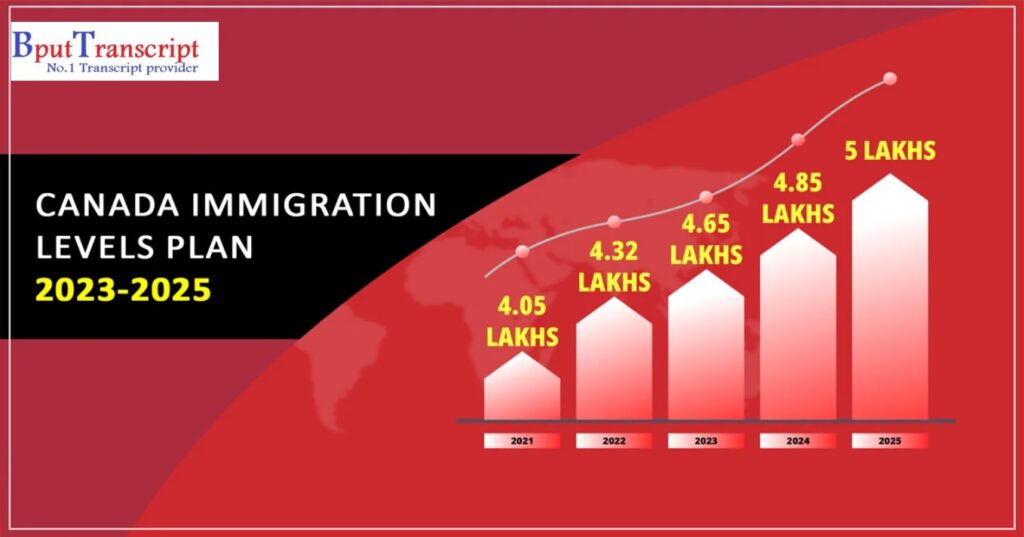
The Canada Immigration Levels Plan for 2023–2025 is a crucial policy document that describes the nation’s strategy for immigration over the following three years. The Canada Immigration Levels plan, which was unveiled by the Canadian government in November 2022, outlines the government’s goals for both the quantity and nature of immigrants it wants to move to canada.
In this post, we’ll take a closer look at Canada’s Immigration Levels Plan for 2023–2025, going over its main components, objectives, and potential effects on the social and economic climate of the nation.
Let’s first take a moment to review the larger context of Canada’s immigration policy before diving deep into the minute details of the 2023–2025 immigration plan. Canada has a long history of opening its doors to immigrants from all across the globe and is now regarded as one of the most hospitable and immigrant-friendly nations in the world. To quantity over 400,000 new immigrants have moved to Canada in 2021 alone, a figure that reflects the nation’s commitment to diversity, inclusivity, and economic growth.
Canada’s immigration levels plan for 2023 to 2025 showcases the government’s target for the number of immigrants it plans to welcome and accommodate to the country over the next three years.
Canada aims to welcome the below-mentioned number of residents in the immigration-level plan.
| Year | Immigration level plan |
| 2023 | 410000-505000 |
| 2024 | 430000-542500 |
| 2025 | 442500-550000 |
The plan also includes a breakup of the immigrants that Canada plans to accept. The majority of new permanent residents in canada as per the immigration plan will be economic immigrants, including skilled workers, entrepreneurs, and investors which by the way will give a huge number of Work Visa, Study Visa and probably Startup Visa to Canadian Immigration application for permanent residency in canada who will be moving to canada. The plan includes family reunification, refugees, and humanitarian ground immigration cases.
Building on this custom, the Immigration Levels Plan(1) for 2023–2025 outlines the government’s objectives for the number and types of immigrants it hopes to bring to the country over the next three years. The plan is created to strike a balance between economic, family, and refugee/humanitarian immigration in order to ensure that Canada continues to welcome a wide variety of people who can contribute to the social and economic well-being of the country.
features of Canada’s latest immigration level plan for 2023-2025
Mentioned below here are some of the key features of Canada’s latest immigration level plan for 2023-2025:
Higher Immigration Target:
The plan’s lofty immigration goals are arguably its most important aspect. Canada expects to accept over 1.2 million new immigrants over the next three years, up from the 401,000 intended in 2021. With a focus on industries like healthcare, technology, and skilled trades, this increase is intended to address labour market shortages and promote economic expansion.
Focus on Economic Immigrants:
The plan puts a lot of effort into luring in economic immigrants, especially those with qualifications and experience that are highly sought after in the Canadian labour market. With a target of 470,000 economic immigrants by 2025, the government intends to increase the number of economic immigrants it admits each year.
Family Immigration:
The government has pledged to maintain levels of family immigration, which includes the sponsorship of spouses, partners, children, parents, and grandparents, even though economic immigration is a major focus of the plan. The plan aims to accept 103,000 family immigrants annually.
Refugee and humanitarian immigration:
The immigration plan also included Refugee and humanitarian immigration in the plan, with a target admission rate of 3500 protected individuals (such as asylum seekers and stateless people) and 22,500 refugees annually. These goals are a reflection of Canada’s ongoing humanitarianism and commitment to giving those in need a safe haven.
Immigration of French Speakers:
The plan includes goals for the immigration of French Speaking nationals as part of its initiatives to support and encourage bilingualism throughout the nation. A significant increase from the 4,000 targets set in the past years, the government plans to accept 13,500 immigrants annually who speak French.
Flexible immigration routes:
The plan emphasises the significance of adaptable immigration ways that can adapt to shifting social and economic circumstances. This includes implementing pilot projects, creating temporary immigration streams, and modifying immigration levels to address changing labour market demands.
Reasons for Canada’s High Immigration Levels
For many years, immigrants have been welcomed with open arms in Canada. Immigration is a major force behind economic expansion and a solution to the nation’s demographic problems. Canada is the most preferred destination for work Visa as well as Study visa for Canadian Citizenship. Some of the primary causes of Canada’s high immigration levels are as follows:
Economic Growth:
The ageing population and falling birth rate in Canada have led to a shrinking workforce, which could have long-term negative effects on the economy. Immigration is thought to be a solution to this problem because it can attract new entrepreneurs and workers who can spur economic growth.
Diversity:
Canada is a multicultural nation with a rich history. Bringing in individuals from various nations and backgrounds is seen as a way to preserve and enhance this diversity.
A key component of Canada’s immigration policy is family reunification. Many Canadians have relatives who reside outside of their country, and immigration enables them to connect with these family members.
Refugees Resettlement:
Canada has a history of supporting this effort and is regarded as a pioneer in it. Canada can offer asylum to people escaping war and persecution thanks to immigration
Why expect higher Canadian immigration targets?
As told by Mr. Sean Fraser in a press conference “Look, folks, it’s simple to me. Canada needs more people” Canada’s Minister of Immigration, Refugees, and Citizenship Canada (IRCC).
In the past, Canada has accepted a large number of immigrants to move to Canada to “support & sustain” its economy. Canada is currently dealing with severe labour shortages and nearly 1 million open positions. The higher immigration targets are the result of both. Statistics show that the 1 million job vacancy shortage was over 80% above pre-pandemic levels and an increase of 2.7% from the previous peak in the last quarter. In recent years, this has been the highest recorded value. In many industries across the nation, there are more open positions than there were a year ago. The healthcare and social assistance industries are some of the most severely impacted. The ageing population and post-pandemic conditions have caused a sharp increase in the demand for professionals in these fields.Canada is looking forward to allowing immigrants via different channels available for immigration be it via a work visa, study visa or even it can be a Canada startup visa programme for permanent residency in Canada.
Potential Impact of Canada’s Immigration Levels Plan
The immigration levels plan for Canada for 2023 to 2025 has the potential to have a huge impact on the economy and society of the nation. A few of the plan’s potential effects include the following:
Economic Growth:
Immigration is anticipated to play a significant role in Canada’s economic growth over the coming years. The influx of new employees and business owners is anticipated to generate new employment opportunities and stimulate innovation, which may result in higher productivity and economic prosperity.
Labour Market issue:
The plan is anticipated to assist in addressing labour shortages in important industries like healthcare, technology, and construction. This might result in better infrastructure and services for Canadians.
Population stability:
Immigration is anticipated to be the main factor driving Canada’s population growth over the coming years. Expanding the workforce and fostering economic growth, this could aid in addressing the demographic issues facing the nation.
Social integration:
Immigration may have both favourable and unfavourable effects on social cohesion. Immigration can contribute to maintaining and enhancing diversity, but if it is not properly managed, it can also cause social tensions. The Canadian government will have to see to it that immigrants are assimilated into society and have access to the tools they require to be successful.
CIMM – Immigration Levels Plan for 2024-2026 – November 07, 2023
Key Facts and Figures
- The 2024-2026 Immigration Levels Plan, tabled in Parliament on November 1, 2023, projects stabilized levels in permanent resident admissions with targets of 485,000 in 2024; 500,000 in 2025; and 500,000 in 2026.
- In 2022, Canada welcomed more than 437,000 new permanent residents, and is on track to meet the target of 465,000 for 2023.
Key Messages
- Canada will continue welcoming newcomers who bring the skills our economy needs. The plan focuses on attracting skilled workers who will contribute to Canada’s economy, while recognizing the importance of family reunification and helping the world’s most vulnerable populations through refugee resettlement.
- This plan upholds the Government’s commitment to bring in 500,000 newcomers by 2025 to help ensure Canada’s economic prosperity. It also allows Canada to maintain its humanitarian tradition while stabilizing overall growth to support positive outcomes for newcomers and those already in Canada.
Responsive
- The multi-year levels plan is developed in consultation with provinces and territories, including Quebec. Under the Canada-Québec Accord, Quebec has full responsibility for the selection of immigrants destined to the province. My Department also consults with stakeholder organizations, and the public.
- While public support for immigration in Canada has remained relatively stable and strong for many years, it can decline quickly if the perception of a well-managed migration system with positive outcomes is lost. Canadians are still likely to see immigration as having a positive effect on economic growth and the availability of labour, however they are also increasingly seeing it as having a negative impact on access to healthcare and the availability of affordable housing, signaling the need to stabilize levels.
Supplementary Information
Media and the public are currently voicing concerns about the immigration system and linking international student rates and temporary resident intake in particular to housing and other absorptive capacity issues; however, the business community generally advocates for increased economic immigration. Canadians are more likely to see immigration as having a positive effect on the availability of labour and economic growth, but a negative impact on healthcare, and especially on the availability of housing.
Over half of all admissions are dedicated to the economic class, reaching over 60% in 2025. Family class will reach 118,000 admissions by 2025 and then stabilize. Refugees and Protected Persons and Humanitarian & Compassionate and Other admissions will fall slightly before stabilizing, in part due to achieving the commitment to bring 40,000 vulnerable Afghans by 2024.

